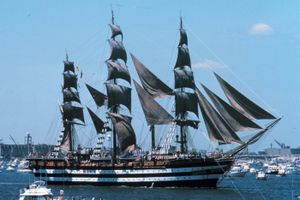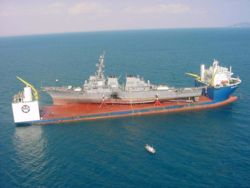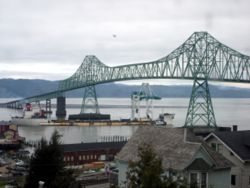Ship
2007 Schools Wikipedia Selection. Related subjects: Air & Sea transport; Engineering

A ship is a large, sea-going watercraft.
A ship usually has sufficient size to carry its own boats, such as lifeboats, dinghies, or runabouts. A rule of thumb saying (though it doesn't always apply) goes: "a boat can fit on a ship, but a ship can't fit on a boat". Consequently submarines are referred to as "boats", because early submarines were small enough to be carried aboard a ship in transit to distant waters. Another type of large vessel which is traditionally called a boat is the Great Lakes freighter. Often local law and regulation will define the exact size (or the number of masts) which a boat requires to become a ship. Compare vessel.
During the age of sail, ship signified a ship-rigged vessel, that is, one with three or more masts, usually three, all square-rigged. Such a vessel would normally have one fore and aft sail on her aftermost mast which was usually the mizzen. Almost invariably she would also have a bowsprit but this was not part of the definition. The same economic pressures which increased sizes to the point of carrying four or five masts, also introduced the fore and aft rig to larger vessels, so few ship-rigged vessels were built with more than three masts. The five-masted Preussen was the outstanding example, but the big German ships and barques were built partly for prestige reasons.
Nautical means related to sailors, particularly customs and practices at sea. Naval is the adjective pertaining to ships, though in common usage it has come to be more particularly associated with the noun ' navy'.
Measuring ships
One can measure ships in terms of overall length, length of the waterline, beam (breadth), depth (distance between the crown of the weather deck and the top of the keelson), draft (distance between the highest waterline and the bottom of the ship) and tonnage. A number of different tonnage definitions exist; most measure volume rather than weight, and are used when describing merchant ships for the purpose of tolls, taxation, etc.
In Britain until the Samuel Plimsoll Merchant Shipping Act of 1876, ship-owners could load their vessels until their decks were almost awash, resulting in a dangerously unstable condition. Additionally, anyone who signed onto such a ship for a voyage and, upon realizing the danger, chose to leave the ship, could end up in gaol.
Samuel Plimsoll, a member of Parliament, realised the problem and engaged some engineers to derive a fairly simple formula to determine the position of a line on the side of any specific ship's hull which, when it reached the surface of the water during loading of cargo, meant the ship had reached its maximum safe loading level. To this day, that mark, called the " Plimsoll Mark", exists on ships' sides, and consists of a circle with a horizontal line through the centre. Because different types of water, (summer, fresh, tropical fresh, winter north Atlantic) have different densities, subsequent regulations required painting a group of lines forward of the Plimsoll mark to indicate the safe depth (or freeboard above the surface) to which a specific ship could load in water of various densities. Hence the "ladder" of lines seen forward of the Plimsoll mark to this day.
Propulsion
Pre-mechanisation
Until the application of the steam engine to ships in the early 19th century, oars propelled galleys or the wind propelled sailing ships. Before mechanisation, merchant ships always used sail, but as long as naval warfare depended on ships closing to ram or to fight hand-to-hand, galleys dominated in marine conflicts because of their maneuverability and speed. The Greek navies that fought in the Peloponnesian War used triremes, as did the Romans contesting the Battle of Actium. The use of large numbers of cannon from the 16th century meant that maneuverability took second place to broadside weight; this led to the dominance of the sail-powered warship.
Steam propulsion
The development of the steamship became a complex process, the first commercial success accruing to Robert Fulton's North River Steamboat (often called Clermont) in the US in 1807, followed in Europe by the 45-foot Comet of 1812. Steam propulsion progressed considerably over the rest of the 19th century. Notable developments included the condenser, which reduced the requirement for fresh water, and the multiple expansion engine, which improved efficiency. As the means of transmitting the engine's power, the paddle wheel gave way to the more efficient screw propeller. The marine steam turbine developed by Sir Charles Algernon Parsons, brought the power to weight ratio down. He had achieved publicity by demonstrating it unofficially in the 100-foot Turbinia at the Spithead naval review in 1897. This facilitated a generation of high-speed liners in the first half of the 20th century and rendered the reciprocating steam engine out of date, in warships.
Most new ships since around 1960 have been built with diesel engines. Rising fuel costs have almost led to the demise of the steam turbine, with many ships being re-engined to improve fuel efficiency. One high profile example was the 1968 built Queen Elizabeth 2 which had her turbines replaced with a diesel-electric propulsion plant in 1986. The last major passenger ship built with steam turbines was the Fairsky, launched in 1984. Some specialised merchant ships have also been built with steam turbines since then, notably Liquefied Natural Gas (LNG) and coal carriers where part of the cargo has been used as fuel for the boilers.
LNG Carriers
LNG carriers in particular have remained a stronghold for steam , and new ships continue to be built with steam turbines in this high growth area of shipping. This is because the Natural Gas is stored in a liquid state in cryogenic vessels onboard these ships. A small amount of "boil off" of gas is required to maintain the pressure and temperature inside the vessels to within operating limits. The "boil off" gas provides the fuel for the ship's boilers, which provide steam for the turbines- the simplest method of dealing with the gas. Technology to operate internal combustion engines (modified marine two stroke diesel engines) on this gas has improved however, so these engines are beginning to appear in LNG carriers; with their greater thermal efficiency, less gas is burnt. Also, developments have been made in the process of re-liquefying "boil off" gas, enabling it to be returned to the cryogenic tanks. The financial returns on LNG are potentially greater than the cost of the marine grade fuel oil burnt in conventional diesel engines, so the re-liquefaction process is starting to be used on diesel engine propelled LNG carriers. Another factor driving the switch from turbines to diesel engines for LNG carriers is the shortage of steam turbine qualified sea going engineers. With the lack of turbine powered ships in other shipping sectors, and the rapid increase in size of the worldwide LNG fleet, not enough have been trained to meet the demand. It may be that the days of the last stronghold for steam turbine propulsion systems are numbered, despite all but sixteen of the orders for new LNG carriers at the end of 2004 being for steam turbine propelled ships.
Diesel propulsion
The marine diesel engine first came into use in 1903 when the rivertanker Vandal was brought into service by Branobel. At the same time it was the first diesel electric ship. It soon offered even greater efficiency than the steam turbine but for many years had an inferior power-to-space ratio. About this period too, heavy fuel oil came into more general use and began to replace coal as the fuel of choice in steamships. Its great advantages were the convenience, the reduction in manning owing to the removal of the need for trimmers and stokers, and the reduction in space required for fuel bunkers. Diesel engines today are broadly classified according to their operating cycle ( two-stroke or four-stroke), their construction ( crosshead, trunk, or opposed piston) and their speed (slow speed, medium speed or high speed). Most modern larger merchant ships use either slow speed, two stroke, crosshead engines, or medium speed, four stroke, trunk engines. Some smaller vessels may operate high speed diesel engines. The operating ranges of the different speed types are as follows;
- Slow speed- any engine with a maximum operating speed up to 300 revs/minute, although most large 2 stroke slow speed diesel engines operate below 120 revs/minute. Some very long stroke engines have a maximum speed of around 80 revs/minute. The largest, most powerful engines in the world are slow speed, two stroke, crosshead diesels.
- Medium speed- any engine with a maximum operating speed in the range 300- 900 revs/ minute. Many modern 4 stroke medium speed diesel engines have a maximum operating speed of around 500 rpm.
- High speed- any engine with a maximum operating speed above 900 revs/ minute
As modern ships' propellers are at their most efficient at the operating speed of most slow speed diesel engines, ships with these engines do not generally require gearboxes. Usually such propulsion systems consist of either one or two propeller shafts each with its own direct drive engine. Ships propelled by medium or high speed diesel engines may have one or two (sometimes more) propellers, commonly with one or more engines driving each propeller shaft through a gearbox. Where more than one engine is geared to a single shaft, each engine will most likely drive through a clutch, allowing engines not being used to be disconnected from the gearbox while others continue to operate. This arrangement allows maintenance to be carried out while under way at sea. Diesel electric is another propulsion system that has been around for a long time, but is becoming more common. By having the engines drive alternators, which supply electricity to motors driving the propellers, gearboxes and clutches can be dispensed with and greater flexibility gained in the positioning of the engines, while still providing the step down in speed required for a medium speed engine to efficiently drive a ships propeller.
The size of the different types of engines is an important factor in selecting what will be installed in a new ship. Slow speed two stroke engines are much taller, but the foot print required- length and width- is smaller than that required for four stroke medium speed diesel engines. As space higher up in passenger ships and ferries is at a premium, these ships tend to use multiple medium speed engines resulting in a longer, lower engine room than that required for two stroke diesel engines. Multiple engine installations also gives greater redundancy in the event of mechanical failure of one or more engines and greater efficiency over a wider range of operating conditions.
Other propulsion systems
Many warships built since the 1960s have used gas turbines for propulsion, as have a few passenger ships, like the jetfoil. Most recently, the Queen Mary 2 has had gas turbines installed in addition to diesel engines. Because of their poor thermal efficiency, it is common for ships using them to have diesel engines for cruising with gas turbines reserved for when higher speeds are required. Some warships and a few modern cruise ships have also utilised steam turbines to improve the efficiency of gas turbines in a combined cycle. In such a combined cycle, where waste heat from a gas turbine is used to create steam for driving a steam turbine, thermal efficiency can be the same or slightly greater than that of diesel engines. However, the grade of fuel required for gas turbines is much more expensive than that required for diesel engines so running costs are higher.
A few ships have used nuclear reactors (like Arktika class icebreaker with 75,000 shaft horsepower), but this is not a separate form of propulsion; the reactor heats steam to drive the turbines. Nonetheless, it has caused concerns about safety and waste disposal. It has become usual only in large aircraft carriers, where the space previously used for ship's bunkerage could then be used instead to bunker aviation fuel, and in submarines, where the ability to run submerged at high speed and in relative quiet for long periods holds obvious advantage. A few cruisers have also employed nuclear power; as of 2006, the only ones remaining in service are the Russian Kirov class.
General terminology
Ships may occur collectively as fleets, squadrons or flotillas. Convoys of ships commonly occur.
A collection of ships for military purposes may compose a navy or a task force.
In the past, people counting or grouping disparate types of ship may refer to the individual vessels as bottoms, but this generally refers only to merchant vessels. Groups of sailing ships could constitute, say, a fleet of 40 sail. Groups of submarines (particularly German U-boats in the 1940s) hunt in wolf packs.
Some types of ships and boats
- Aircraft carrier
- Barge
- Bulk carrier
- Cable Layer
- Capital ship
- Cargo ship
- Catamaran
- Coaster
- Container ship
- Corvette
- Crane vessel
- Cruise ship
- Cruiser
- Cutter
- Destroyer
- Diving support vessel
- Drillship
- Dredger
- Ferry
- Frigate
- FPSO ( Floating_Production_Storage_and_Offloading)
- Guided missile cruiser
- Hopper, Hopper barge, Split hopper barge
- Hovercraft
- Hydrofoil
- Icebreaker
- Jetfoil
- Junk
- Landing craft
- Lake freighter
- Livestock carrier
- LNG carrier
- Lugger
- Minesweeper
- Minehunter
- Ocean liner
- Packet ship
- Panamax
- Reefer (refrigerated ship)
- Research vessel
- RO-RO ship (roll on, roll off, Auto carrier)
- Sailing ship
- Selfdischargers
- Semi-submersible
- Sloop
- Submarine
- Supertanker
- Supply boat, Supply ship
- Survey Vessels
- Tanker
- Tender
- Train ferry
- Tugboat
- Yacht
Some historical types of ships and boats
- Barque A sailing vessel with three or more masts, fore-and-aft rigged on only the aftermost.
- Barquentine A sailing vessel with three or more masts, square-rigged only on the foremast.
- Battle cruiser A lightly-armoured battleship.
- Battleship A large, heavily-armoured and heavily-gunned warship. A term which generally post-dates sailing warships.
- Bilander
- Bireme An ancient vessel, propelled by two banks of oars.
- Birlinn
- Blockade runner A ship whose current business is to slip past a blockade.
- Brig A two-masted, square-rigged vessel.
- Brigantine A two-masted vessel, square-rigged on the foremast and fore-and-aft rigged on the main.
- Caravel A much smaller, two, sometimes three-masted ship.
- Carrack
- Clipper A fast multiple-masted sailing ship, generally used by merchants because of their speed capablities.
- Cog
- Collier A vessel designed for the coal trade.
- Dreadnought An early twentieth century class of battleship.
- Dromons are the precursors to galleys.
- East Indiaman An armed merchantman belonging to one of the East India companies (Dutch, British etc.)
- Fire ship A vessel of any sort, set on fire and sent into an anchorage with the aim of causing consternation and destruction. The idea is generally that of forcing an enemy fleet to put to sea in a confused, therefore vulnerable state.
- Fleut A Dutch-made vessel from the Golden Age of Sail. It had multiple decks and usually three square-rigged masts. It was usually used for merchant purposes.
- Galleass A sailing and rowing warship, equally well suited to sailing and rowing.
- Galleon A sixteenth century sailing warship.
- Galley A warship propelled by oars with a sail for use in a favourable wind.
- Galliot
- Ironclad A wooden warship with external iron plating.
- Knarr A type of Viking trade ship
- Liberty ship An American merchant ship of the late Second World War period, designed for rapid building in large numbers. (The earliest class of welded ships.)
- Longship A Viking raiding ship
- Man of war A sailing warship.
- Monitor A small, very heavily gunned warship with shallow draft. Designed for land bombardment.
- Paddle steamer A steam-propelled, paddle-driven vessel, a name commonly applied to nineteenth century excursion steamers.
- Pantserschip A Dutch ironclad. By the end of the nineteenth century, the name was applied to a heavy gunboat designed for colonial service.
- Penteconter An ancient warship propelled by 50 oars, 25 on each side.
- Pram A small dinghy, originally of a clinker construction and called in English, as in Danish, a praam. The Danish orthography has changed so that it would now be a pråm in its original language. It has a transom at both ends, the forward one usually small and steeply raked in the traditional design.
- Q-ship A commerce raider camouflaged as a merchant vessel.
- Quinquereme An ancient warship propelled by three banks of oars. On the upper row three rowers hold one oar, on the middle row - two rowers, and on the lower row - one man to an oar.
- Schooner A fore and aft-rigged vessel with two or more masts of which the foremast is shorter than the main.
- Shallop A large, heavily built, sixteenth century boat. Fore and aft rigged. More recently it has been a poetically frail open boat.
- Slave ship A cargo boat specially converted to transport slaves.
- Small Waterplane Area Twin Hull (SWATH) A modern ship design used for Research Vessels and other purposes needing a steady ship in rough seas.
- Steamship A ship propelled by a steam engine.
- Ship of the line A sailing warship of first, second or third rate. That is, with 64 or more guns. Before the late eighteenth century, fourth rates (50-60 guns) also served in the line of battle.
- Torpedo boat A small, fast surface vessel designed for launching torpedoes.
- Tramp steamer A steamer which takes on cargo when and where it can find it.
- Trireme An ancient warship propelled by three banks of oars.
- Xebec
- Victory ship


